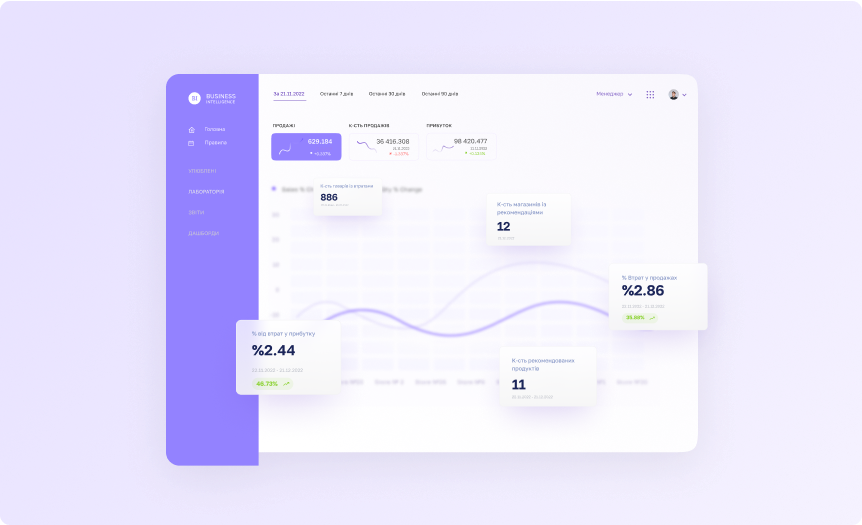Datawiz BI
Usługa analityczna Datawiz BI pomaga sprzedawcom detalicznym w 17 krajach skutecznie analizować dane, tworzyć informacyjne pulpity nawigacyjne i łatwo udostępniać je w przyjaznym dla użytkownika interfejsie.
Czytaj więcejNiezawodny asystent dla właścicieli sieci, menedżerów kategorii i marketerów. Pozwala w ciągu kilku sekund obliczyć ważne wskaźniki detaliczne i podejmować decyzje w oparciu nie o intuicję, ale o dokładne dane

Usługa analityczna Datawiz BI pomaga sprzedawcom detalicznym w 17 krajach skutecznie analizować dane, tworzyć informacyjne pulpity nawigacyjne i łatwo udostępniać je w przyjaznym dla użytkownika interfejsie.
Czytaj więcej
The free Business Calculator from Datawiz is fast and easy to use. To start an online calculation:
To change the currency in the Business Calculator for calculating indicators online, you need to click on the "Сurrency" field and select the desired option from the drop-down list.
You can correct the entered data in the calculator online by using the arrows or manually changing numbers.
To clear the calculation results, click the "Reset" button.
The selling price is the price at which a product is sold. It is calculated using one of the formulas:
The calculation of profit for the store can be made according to the formulas:
Margin, % is the amount of profit that the chain receives for every $100 of sales. It shows the profitability of goods and the efficiency of the store.
In absolute terms, margin and gross profit are the same. The formula for calculating these indicators is the same: Price - Cost Price.
However, the calculation of the margin in percentage form will differ and reflect the profitability of the goods.
Margin is calculated in percentage form by using one of the following formulas:
Markup,% is an additional value on the cost price of the goods, which shows how much the profit is added to each $100 of purchased goods. The markup is calculated from the purchase price (cost price) of goods.
The calculation of the markup in percentage form is made according to one of the formulas:
The additional value in price is actually the markup or margin in absolute terms. But it should be understood that the margin is used in the context of the purchase price (cost price), and the margin is used in the context of the selling price. At the same time, in percentage terms, the values of the margin and the markup differ significantly.
Read more about the differences between the margin and the markup in thearticle.
The inventory turnover ratio shows how many turns (from purchase to sale) the goods performed during the selected period. This indicator allows you to evaluate the sales speed of goods, identify non-selling goods and optimize the assortment of the chain.
It means that during the selected period, all goods completed 1.5 turns - from purchase to sale.
Days sales in inventory - indicates how many days the good takes to complete one turn. In other words, how many days one turn lasts: from the purchase of goods to their sale.
It means that one turn (from purchase to sale) of goods in the chain lasts 4 days. This fact should be taken into account for scheduling the supply of goods.
Inventory turnover indicators have a different positive trend:
! The desired situation for the retailer: ↑ Turnover ratio and ↓ Days sales in inventory, which indicate an acceleration in the turnovers of goods and the release of funds from circulation.
Read more about turnover ratio, their content, and calculation algorithms in the article.